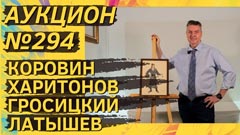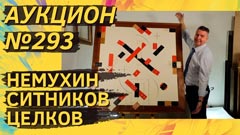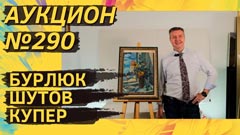
1960s UNOFFICIAL ART
KRASNOPEVTSEV Dmitry Mikhailovich (1925–1995) Still life with a Sea Star. 1964. Hardboard, oil. 41.7 × 47.5
1964 is the beginning of a particularly valuable “monochrome period”, when for the sake of silence and peace Krasnopevtsev muted the colors of the previously bright palette. This method had a striking effect. The rejection of shadows and garish colors, the utmost laconism and pictorial austerity allowed the artist to highlight the main thing in his still lifes — harmony, balance, the beauty of peace.
“Still life with a Sea Star” is a brilliant example of Krasnopevtsev's work. Museum level. Large size. And in general, a complete investment set: the work has already been published in Ushakov's collected book (on page 56), and is also accompanied by an expert opinion by Valery Silaev.
KALININ Vyacheslav Vasilievich (1939–2022) The ruins of a barn in my village. 1988. Oil on canvas. 120 × 140
In Vyacheslav Kalinin's large 2014 composite catalog, on page 138, there is a large photo of the 1988 painting “The ruins of a barn” with an interesting comment: it was exhibited at the Eduard Nakhamkin Fine Arts Gallery in New York, and its current location is unknown. But the intrigue doesn't last long. Voila! The location is now known. The painting has crossed the ocean and now stands alive at ArtSale.info auction. Of course, we compared and checked. It's definitely not the author's copy (which is not uncommon for Kalinin), but it's the one that was published.
Kalinin is a sixties artist. He is among the first names of unofficial art. In the USSR, he exhibited semi-underground. Mostly at apartment exhibitions. Only after the opening of the hall of the Gorkom (the City Committee of Graphics) on Malaya Gruzinskaya, he gained access to the general public. Kalinin is a singer of the urban grassroots. He was inspired by the life and customs of the street, the atmosphere of parties with wine and wicked girls. And in the “The ruins of a barn” are also present symbols of dissolute life. But at the same time in this picture there is no grotesque half-naked debauchery. The thing favorably distinguishes special lyricism, melancholy and romance. Definitely a decoration of the collection. And absolutely museum level.
SITNIKOV Vasily Yakovlevich (1915–1987) Scythe and sickle. 1985. Cardboard, colored pencils, watercolor, whitewash. 70 × 40
Once again, a great rarity. Not just Sitnikov, but Sitnikov published, with impeccable provenance, signed, and with the author's title preserved. A photo of this drawing can be found in the book “The Life of Vasil Yaklich Sitnikov written and drawn by himself. Collected preserved and supplemented KKKuzminsky and EKP, 1985–2009” on page 162.
This is a dashing, virtuosic, charged painting! It is destined to become the center of attraction in any collection. Sitnikov is historically among the top most expensive artists of the sixties. In the fat years, one of his paintings wal sold for $627,000. With that said, he is self-taught. All of his “universities” are museums, libraries, and lectures at the Surikov School, where he worked on a display of transparencies (hence his nickname, “Lanternist”). Dozens of artists passed through his informal “Sitnikov Academy”, including the young Vladimir Yakovlev.
In 1975, Sitnikov handed over his multimillion-dollar icon collection to the state and emigrated from the USSR. He died in the United States in 1987.
GROSITSKY Andrey Borisovich (1934–2017) Broken hammer. 1997. Oil on canvas, mixed media. 105 × 95
One-meter spectacular size, the characteristic “instrumental” plot and the trademark technique with the subject breaking out of the boundaries of the canvas. The “poetry of things” in its purest form is the main thing that collectors expect from Andrey Grositsky.
Grositsky was an artist of the sixties and exhibited at a high-profile exhibition in the House of Culture pavilion at the VDNKh in 1975, and later at the Gorkom on Malaya Gruzinskaya Street. He is the creator of his own inimitable artistic language and system of images. The artist enjoys the beauty of the object world and makes meat grinders, locks, shovels, hammers and other objects come alive as characters in his works.
NEMUKHIN Vladimir Nikolaevich (1925–2016) Kursky. Kazansky. Yaroslavsky. Paveletsky. 2005. Canvas on plywood, acrylic, assemblage. 89.6 × 68.5
This work is the focus of several cycles of Vladimir Nemukhin. It combines the station Moscow, the card theme, and the jack technique. This particular painting was exhibited at the Moscow Museum of Modern Art on Petrovka 25 in 2009. A resonant exhibition from the collection of Iosif Badalov was a discovery for many, a door to the world of unofficial art. Fourteen years ago, selected works by Steinberg, Nemukhin, Yakovlev were presented there — the entire first row. Naturally, we were at that exhibition, taking pictures in the hall. And in one of them, you can just see this painting in the exhibit. And on top of that, this work was published in the catalog “The Tradition of Nonconformism”, which has now become a bibliographic rarity.
YAKOVLEV Vladimir Igorevich (1934–1998) Abstract composition. 1975. Paper, gouache. 43 × 61
The marathon of published masterpieces continues with Vladimir Yakovlev's 1975 “Abstract composition”. The signed, dated drawing was exhibited at the State Literary Museum in 2014 at an exhibition in honor of the artist's 80th birthday and published in the catalog “And I want to stay in this light...” An appeal to abstraction in Yakovlev's work is not exceptionally rare. But it should be understood that such works occur many times rarer than flowers and portraits. In short, true connoisseurs of the creativity of the “artist of freedom” — do not miss it.
PIVOVAROV Viktor Dmitrievich (1937) Third eye. 1989. Paper on canvas, watercolor, pastel, pencil, oil, mixed media. 38 × 48
The ironic, subtle, philosophical Pivovarov. A representative of Moscow's romantic conceptualism, an artist of the Sretensky Boulevard group, who has lived in the Czech Republic for many years.
The authenticity of the work is confirmed by a certificate signed by the artist.
NESTEROVA Natalya Igorevna (1944–2022) Diana. 2007. Oil on canvas. 150 × 125
We were told that “Diana” belonged to the number of works that Nesterova was particularly fond of, considered creative successes. Roman Diana is the “goddess of forests”, the patroness of animals and plants, the goddess of fertility. Her statues often depict her with a bow, accompanied by a dog. The most famous in this iconography is the marble Diana of Versailles in the Louvre. Nesterova, however, was inspired by another garden sculpture. The arrow has just been released, the dog is barking, Diana looks off into the distance, and the denouement is near. All this drama, however, is frozen in stone. And all around, quiet life is flowing. People walk in the park and indulge in the luxury of human interaction. In general, it is precisely this “human”, the simple joys and pleasures — the main theme of Nesterova's creativity. Her paintings are almost always full of inner optimism. And this energy is highly appreciated by collectors.
RUSSIAN CLASSICS
ISUPOV Alexey Vladimirovich (1889–1957) Early spring. 1915. Cardboard, graphite pencil, tempera, watercolor. 23.8 × 62.6
A rare guest in our latitudes. Alessio Isupoff is a classicist from the “Union of Russian Artists”, an Itinerant, a student of Konstantin Korovin and Apollinary Vasnetsov.
Sleigh with scattered firewood, spring, muddy weather, a horse, and a sturdy wooden house — such a picture can be observed today if you wish. Little has changed in more than a hundred years in the Russian countryside (for example, in his native Vyatka region). The work was written in 1915, before the emigration of Alexey Isupov. According to a number of testimonies, his departure was not political. Isupov was a participant in the exhibitions of the Itinerants and a member of the Association of Revolutionary Artists of Russia. He went to Italy for medical treatment and is said to have shunned Russian emigration. But his paintings, written abroad, bequeathed to the Russian museums. Which was done.
The authenticity of the drawing is confirmed by the expert opinion of the Grabar Center.
- Log in to post comments










